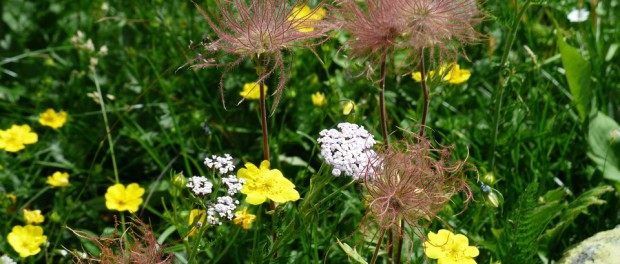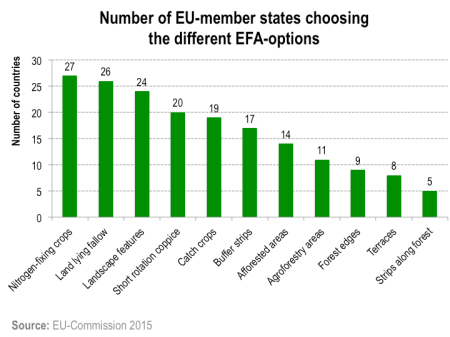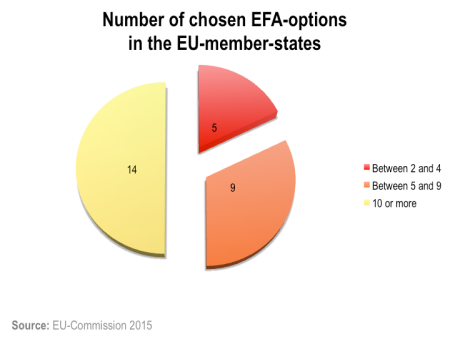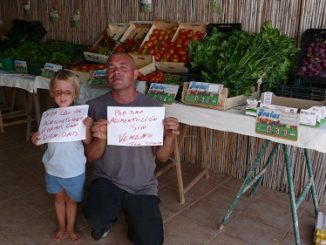“Ecological focus areas should be established, in particular, in order to safeguard and improve biodiversity on farms“. So say the official EU documents. And yet for these EFAs, Member States are choosing ‘productive options’ – in particular catch crops and nitrogen fixing crops – over biodiversity. Using newly released data, Sebastian Lakner shows us just how ineffective and poorly targeted EFAs are, in Germany and beyond.

As one main element of the EU’s CAP-Reform 2013, the Greening of EU Direct Payments has been implemented in 2015 as #the first full year. In the last weeks some first data on the implementation of Greening and the Ecological Focus Area (EFA) were unofficially presented by the EU Commission. I want to share these data and do a bit of commenting on them.
Farmers have to fulfill three criteria (crop diversification, maintenance of permanent grassland and the ecological focus area (EFA) to receive 30% of the direct payments. There are some exemptions for very small farms (< 10 ha), some simplified criteria for small farms (10-30 ha) and some exemptions for farms with a high share of permanent grassland or fodder production on arable land. The EU-Commission provides some general information on greening and the member-states have some flexibilities in the implementation of Greening on a national level. So most of the information was provided by national authorities, since the Greening-regulations are dependent on the decisions taken in the member-states.
In December 2015, EU member states had to report the figures of the first year of implementation to the EU-Commission. I already reported on the implementation of Greening and EFA in Germany, since the German ministries (in the Federal States and in Berlin/Bonn) published the implementation data in great detail. So it was possible to draw some first conclusions, even though it is clear, that farmers choices will still change to some extent in the coming years, when all the details are known and farmers have more time to take their decisions on how to comply with Greening.
The EU-Commission also published a document on the national choices with respect to all the flexible elements of the CAP-Reform. From this document, it is clear that full flexibility was taken at national level. With respect to the ecological focus area, different options are offered on the national level. The following figure 1 shows the number of countries in which the different EFA-options are chosen:

So the most chosen option are 1.) nitrogen fixing crops, 2.) land lying fallow and 3.) Landscape features. Figure 2 illustrates the number of options chosen in the EU member-states:

(both figures adapted from pg 13 of this EU Commission document)
The ‘productive options’ catch crops and nitrogen fixing crops together take the largest part (53%). Landscape elements and buffer strips, as very effective measures to protect species and link structures within the landscape, have only 11% of arable land (after applying WF). Note that the real shares are given by the figures before applying weighting factors (WF), so the proportion of landscape elements and buffer strips are around 5% all together. Countries with the largest shares of landscape elements are Ireland (by far!), United Kingdom, Malta, (surprisingly) Germany and Sweden. Buffer strips are of the registered in Denmark, United Kingdom and Ireland. Also interesting is the fact that many of the two forest-options don’t play a role: There is a bit of short rotation coppice in Finland and Denmark and a bit afforested area in Portugal, Poland, Hungary and Spain. But on the EU-levels, these options play – with 1% – a minor role.
If we take a look into the main reform document, EU-Regulation No. 1307/2013 of the European Parliament and of the Council of 17 December 2013, argument (44), we find the main motivation for the Ecological Focus Area (EFA): “Ecological focus areas should be established, in particular, in order to safeguard and improve biodiversity on farms“. So EFA is about Biodiversity! Ecologists tell us, that mainly buffer strips, landscape element and land lying fallow only show a significant impact on biodiversity. The other elements might be in one or the other way beneficial for the environment in general, however their effect on biodiversity is probably rather limited.
Conclusions: A substantial reform of Greening or beyond is necessary
The preliminary data show that only about 45% of the EFA-area (after WF) useful options are chosen. If we take real area, the share is just about 26%, which is disappointing. There is a lot of excess in this system, especially if we take into account the administrative costs of implementing Greening. Note that the figures vary substantially between the member states. So I am already looking forward to analyze the full published data-set. Note also that some national experts evaluate the EFA-effects a bit differently across the countries.
The figures clearly show: Greening and the EFA is not the best instrument to perform targeted support of biodiversity and especially endangered species. EFA might contribute for a more broad extensification of arable land – if we take this as an objective for EFA. So from an environmental point it might be worth to think about a pragmatic improvement of EFA. But we need other more effective instruments for a targeted support of biodiversity and endangered species. Greening and EFA are not the solution to this problem.
It is still too early to give a final comment on the figures, since we don’t have more precise and detailed data. And 2015 is just the first year, so given the low commodity prices for agricultural goods, I would expect e.g. the fallow land to be chosen more often in 2016. Also the buffer strips might gain a bit, since the regulations are more clear this year and farmers know how to implement buffer strips.
On the other hand, my two main argument remain the low efficiency of EFA and Greening and the lack of effectiveness of EFAs for endangered species. And remember: The endangered species are the main objective of EFA. This still highlights the potential but also the necessity to substantially adjust the EFA-measures and to financially increase the share of Pillar II and also to reform Pillar II-programs. I will comeback to this in a few months, when more data are available.
Did I miss something or is something unclear? Just write or comment, I am happy about feedback!
Thanks to Dr. Jürgen Wilhelm from the Ministry for Agriculture in Lower Saxony for presenting some of the data in Loccum and for fruitful discussion. Also note that not all data stem from Dr. Wilhelm and I won’t take any guarantee on the data, which are still preliminary.
This article first appeared on Sebastian Lakner’s Blog





